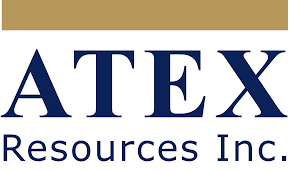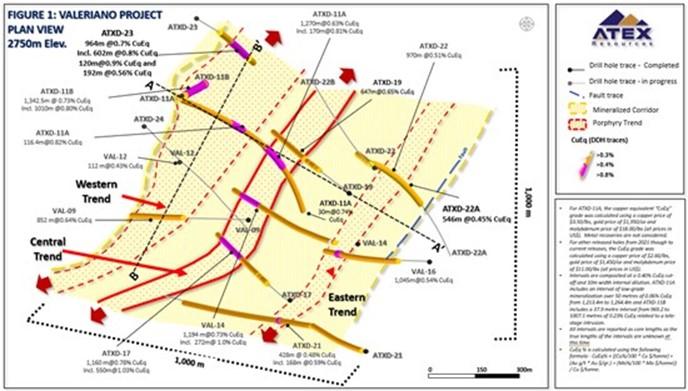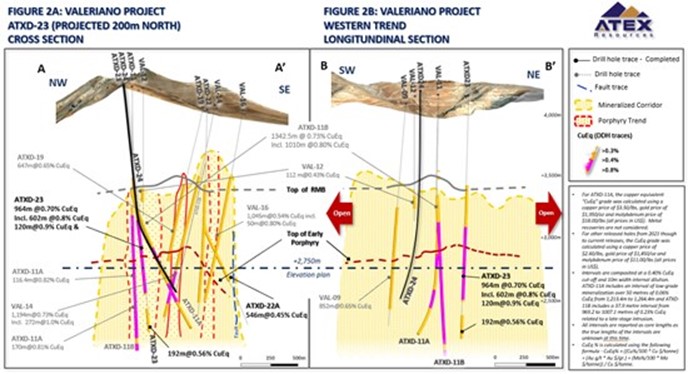
ATEX Intersects 0.70% CuEq over 964m in a 200m Step-Out Along the Recently Discovered High-Grade Western Porphyry Trend
ATEX Resources Inc. (TSX-V: ATX) is pleased to announce complete assay results for drill holes ATXD-22A and ATXD-23 from its Phase III drill campaign at the Valeriano Copper-Gold Project located in Atacama Region, Chile.
Highlights include:
- ATXD-23 successfully extended the high-grade trend discovered in ATXD-11B, intersecting 964 metres of 0.70% Copper Equivalent (0.48% Cu, 0.24 g/t Au and 78 ppm Mo) (Figures 1, 2A & 2B) starting at 782 metres and including:
- 602 metres of 0.80% CuEq (0.50% Cu, 0.37 g/t Au and 11 ppm Mo) from 1,130 metres, and
- 120 metres of 0.90% CuEq (0.45% Cu, 0.54 g/t Au and 3ppm Mo) starting at 1,612 metres.
- Additionally, ATXD-23 intersected 192 metres of 0.56% CuEq (0.24% Cu, 0.40 Au and 4ppm Mo) from 1,858 metres to the bottom of the hole, ending in mineralization.
- The newly discovered Western Porphyry Trend now has a strike length of approximately 700 metres and remains open. The Phase IV program will include holes testing further extensions of this high-grade discovery.
- ATXD-22A (daughter hole), targeting the Eastern Porphyry Trend, intersected 546 metres of 0.45% CuEq (0.32% Cu, 0.08 g/t Au and 173 ppm Mo) from 921.4 meters downhole.
- This mineralization continues from hole ATXD-22 (mother hole) grading 0.44% CuEq over 292 metres from 630 to 922 metres (0.31% Cu, 0.01 g/t Au and108 ppm Mo) (See March 30 release) above the kickoff point for ATXD-22A.
- The final two holes of the program, ATXD-24 and ATXD-22B reached depths of 1,842.4 metres and 1,615.05 metres respectively, with ATXD-24 paused in early porphyry within the Central Trend and ATXD-22B in potassic altered, mineralized rock milled breccia “RMB” approaching the Central Trend extension.
- Both holes were paused due to earlier-than-expected adverse weather conditions.
- Samples for the partial holes ATXD-24 and ATXD-22B have been sent to the lab with results expected by late June or early July.
“We are incredibly happy and proud of how well our team and partners were able to execute throughout this campaign,” stated Raymond Jannas, President, and CEO of ATEX. “The Phase III program has delivered on, and exceeded, its stated objectives, expanding the mineralized footprint, confirming continuity along the Central High-Grade Trend, and testing new targets. This has led to the discovery of a new high-grade porphyry trend, the Western Trend where ATXD-11B, the highest-grade hole of the Phase III was drilled. The overall size of the system has grown to 1,000 metres long by 1,000 metres wide with a vertical extent of 1,000 metres. Within this footprint we have confirmed two high-grade porphyry trends and have demonstrated their continuity with multiple drill intersections in both. We are looking forward to completing a full review of these results and integrating them into our plans for Phase IV, where we intend to continue demonstrating the enormous potential of the Valeriano Porphyry system. We are also working towards an updated mineral resource estimate incorporating drilling up to and including Phase III. We expect to update investors on this in the coming months.”
Table 1. ATXD-23 and ATXD-22A Results
| Hole ID | From | To | Interval2,3 | Cu | Au | Mo | CuEq1 | Hole Length (metres) |
| (metres) | (metres) | (metres) | % | g/t | ppm | % | ||
| ATXD-23 | 782.00 | 1,746.00 | 964.00 | 0.48 | 0.24 | 78 | 0.70 | 2,050.5 |
| incl. | 1,130.00 | 1,732.00 | 602.00 | 0.50 | 0.37 | 11 | 0.80 | |
| incl. | 1,612.00 | 1,732.00 | 120.00 | 0.45 | 0.54 | 3 | 0.90 | |
| and | 1,858.00 | 2,050.05 | 192.05 | 0.24 | 0.40 | 4 | 0.56 | |
| ATXD-22* | 630.00 | 1,600.00 | 970.00 | 0.38 | 0.10 | 99 | 0.51 | 1,712.0 |
| incl. | 630.00 | 922.00 | 292.00 | 0.31 | 0.01 | 108 | 0.44 | |
| ATXD-22A** | 921.35 | 1,468.00 | 546.65 | 0.32 | 0.08 | 173 | 0.45 | 1,871.0 |
1 The CuEq grade was calculated using a copper price of $2.60/lb, gold price of $1,450/oz and molybdenum price of $11.00/lb (all prices in US$). Metal recoveries are not considered. CuEq is calculated using the following formula – CuEq% = ((Cu%/100 * Cu $/tonne) + (Au g/t * Au $/gr.) + (Mo%/100 * Mo $/tonne)) / Cu $/tonne.
2 Intervals are composited at a 0.40% CuEq cut-off and unless otherwise stated a maximum of 10 metres of internal dilution.
3 All intervals are reported as core lengths as the true lengths of the intervals are unknown at this time.
* ATXD-22 Was initially reported by the Company on March 30, 2023.
** ATXD-22A continues from mineralized interval in ATXD-22 from 630 metres to 922 metres.
Results
The intervals reported in ATXD-23 (Table 1) are interrupted by a 112-metre interval of intermineral porphyry from 1,746 to 1,858 metres downhole. This interval of IMP grades 0.24% CuEq (0.11% Cu, 0.16 g/t Au and 2 ppm Mo). ATXD-23 was drilled at a sub vertical angle (-83 degrees) and drilled along the intermineral porphyry before exiting back into the early porphyry. Phase IV drill plans for the Western Trend will include drill holes with intersection angles planned to drill across the target geology and better test the width of the trend.
ATXD-22A (Daughter hole) commenced at a depth of 921.4 metres and was drilled southeast to test the northern extension of the Eastern Trend. It was targeted to intersect this trend approximately 400 metres north of VAL-16 (1,045 metres of 0.54% CuEq (0.39% Cu, 0.17 g/t Au & 54 ppm Mo)). The hole commenced in mineralized RMB from its start point at 921 metres downhole in ATXD-22. Mineralization and alteration in the hole decreased as the hole intersected a series of faults that ultimately cut-off mineralization.
ATXD-24 was drilled to the southeast across the eastern contact of the Western trend and towards the Central Trend. The hole intersected chalcopyrite bearing, mineralized RMB and a series of intermineral porphyries starting from a depth of 580 metres to a depth of 1,350 metres. Several chalcopyrite bearing hydrothermal breccia units were observed from 1,350 metres to 1,525 metres downhole. Strong potassic alteration with intense stockwork and veining was intersected within the early porphyry from 1,525 metres to where the hole was paused at 1,842.4 metres. Assay results from ATXD-24 are expected in late June or early July.
ATXD-22B (daughter hole), targeting the Central High-Grade Trend extension, commenced at a depth of 444 metres downhole from ATXD-22(mother hole). The hole intersected chalcopyrite bearing argillic altered RMB from 595 metres to a depth of 1,100 metres. From 1,100 metres, to where the hole was paused due to weather conditions, potassic altered chalcopyrite bearing RMB was intersected, including zones of veining with visible chalcopyrite and bornite mineralization. The hole has been left in a condition to be re-entered and completed, as an option in Phase IV, and results are expected by late June or early July.
The Phase III campaign commenced in October 2022 and has been completed in late May 2023. In total 12,513 metres of drilling were completed in eight drill holes including four holes from surface, and four daughter holes drilled from existing holes. A summary of results for phase III is presented in Table 2. There are two holes still to be reported from Phase III, ATXD-24 and ATXD-22B which are expected to be announced in late June or early July.
Phase III achieved a series of execution records for the project including completing the deepest hole to date at a depth of 2,190.5 metres (ATXD-11B) as well as achieving a 100% completion rate on drill holes. Additionally, the utilization of directional drilling in Phase III resulted in a saving of ~3,000 metres of drilling from surface. Phase IV, which will follow up on the success achieved in Phase III, is expected to commence in October 2023.
Figure 1 Valeriano Project Plan View
Figure 2A and 2B Valeriano Cross Section and Western Long Section
Table 2. Phase III Results Summary
| Hole ID | From | To | Interval2 | Cu | Au | Mo | Cu Eq | Hole Length (m) and Objective |
| (metres) | (metres) | (metres) | (%) | (g/t) | (ppm) | (%) | ||
| ATXD-11A | 860.0 | 2130.0 | 1270.0 | 0.43 | 0.21 | 52 | 0.63 | 2,130 m – daughter from VALDD-11. Tested Western and Central Trends |
| incl. | 1048.0 | 1213.4 | 165.4 | 0.51 | 0.20 | 105 | 0.73 | |
| and | 1376.0 | 1492.4 | 116.4 | 0.56 | 0.30 | 95 | 0.82 | |
| Incl. | 1376.0 | 1393.3 | 17.3 | 0.73 | 0.30 | 39 | 1.01 | |
| and incl. | 1450.0 | 1470.0 | 20.0 | 0.64 | 0.30 | 308 | 1.06 | |
| and | 1698.0 | 2130.1 | 432.1 | 0.48 | 0.30 | 12 | 0.71 | |
| incl. | 1698.0 | 1868.0 | 170.0 | 0.54 | 0.30 | 11 | 0.81 | |
| also incl. | 1730.0 | 1752.0 | 22.0 | 0.66 | 0.40 | 11 | 0.95 | |
| and | 1816.7 | 1836.0 | 19.3 | 0.56 | 0.50 | 10 | 0.94 | |
| and | 1854.0 | 1868.0 | 14.0 | 0.60 | 0.50 | 11 | 1.00 | |
| and | 2100.0 | 2130.1 | 30.1 | 0.53 | 0.20 | 19 | 0.73 | |
| ATXD-21 | 846.0 | 1274.0 | 428.0 | 0.31 | 0.20 | 56 | 0.48 | 1,838 m – Drilled from surface. Tested above Eastern Trend didn’t reach Central Trend |
| incl. | 850.0 | 902.0 | 52.0 | 0.34 | 0.20 | 73 | 0.53 | |
| incl. | 1020.0 | 1044.0 | 24.0 | 0.32 | 0.20 | 38 | 0.52 | |
| incl. | 1084.0 | 1252.0 | 168.0 | 0.41 | 0.20 | 60 | 0.59 | |
| and | 1492.0 | 1532.0 | 40.0 | 0.27 | 0.10 | 68 | 0.41 | |
| ATXD-11B | 848.0 | 2190.5 | 1342.5 | 0.46 | 0.31 | 43 | 0.73 | 2,190.5 m – Daughter from VALDD-11. Discovery hole on Western Trend |
| incl. | 1078.0 | 2088.0 | 1010.0 | 0.50 | 0.35 | 29 | 0.80 | |
| incl. | 1438.0 | 2088.0 | 650.0 | 0.46 | 0.44 | 13 | 0.83 | |
| incl. | 1864.0 | 2086.0 | 222.0 | 0.46 | 0.58 | 13 | 0.94 | |
| incl. | 1964.0 | 2086.0 | 122.0 | 0.47 | 0.65 | 14 | 1.01 | |
| ATXD-22 | 630.0 | 1600.0 | 970.0 | 0.38 | 0.10 | 99 | 0.51 | 1,712 m – Drilled from surface – Mother hole between Central and Eastern Trends |
| incl. | 1016.0 | 1128.0 | 112.0 | 0.57 | 0.14 | 212 | 0.77 | |
| and | 1426.0 | 1568.0 | 142.0 | 0.4 | 0.11 | 55 | 0.51 | |
| ATXD-23 | 782.00 | 1,746.00 | 964.0 | 0.48 | 0.24 | 78 | 0.70 | 2,050.5 m – Drilled from Surface testing Western Trend extension |
| incl. | 1,130.00 | 1,732.00 | 602.0 | 0.50 | 0.37 | 11 | 0.80 | |
| incl. | 1,612.00 | 1,732.00 | 120.0 | 0.45 | 0.54 | 3 | 0.90 | |
| and | 1,858.00 | 2,050.05 | 192.1 | 0.24 | 0.40 | 4 | 0.56 | |
| ATXD-22A | 921.35 | 1,468.00 | 546.7 | 0.32 | 0.08 | 173 | 0.45 | 1,871 m – daughter from ATXD-22 testing Eastern Trend |
* Please see Company releases noted below for full details on Phase III results:
- ATXD-11A – Released Feb 07, 2023
- ATXD-21 – Released Feb 27, 2023
- ATXD-11B & ATXD-22 – Released March 30, 2023
Outlook
Final assay results for the remaining holes of the Phase III drill program are expected by the end of June or early July. The Company intends to use these the Phase III results and data to update the copper-gold mineral resource statement for the Valeriano Project and file an updated NI-43 101 compliant technical report. Additionally, metallurgical test work using core from the Phase III program is being undertaken by Atex in conjunction with Libertas Metallurgy and Base Met Labs of Kamloops BC. This work is expected to be completed in Q3.
QAQC
Drill holes are collared with a PQ drill bit, reduced to HQ and, sequentially, to NQ as the drill holes progressed deeper. Drill core produced by the drill rigs was extracted from the core tubes by the drill contractor under the supervision of ATEX employees, marked for consistent orientation and placed in core boxes with appropriate depth markers added. Full core boxes were then sealed before being transported by ATEX personnel to the Valeriano field camp. Core at the field camp is processed, quick logged, checked for recovery, photographed, and marked for specific gravity, geotechnical studies and for assays. From camp, the core is transferred to a secure core-cutting facility in Vallenar, operated by IMG, a third-party consultant. Here, the core trays are weighed before being cut using a diamond saw under ATEX personnel oversight. ATEX geologists working at this facility double-check the selected two-metre sample intervals, placing the samples in seal bags and ensuring that the same side of the core is consistently sampled. Reference numbers are assigned to each sample and each sample is weighed. The core trays with the remaining half-core are weighed and photographed. Additionally, core logs are updated, and the specific gravity and geotechnical samples are collected. The remaining core is stored in racks at the Company’s secure facility in Vallenar.
From Vallenar samples are sent to an ALS preparation facility in La Serena. ALS is an accredited laboratory which is independent of the Company. The prepared samples were sent to the ALS assay laboratories in either Santiago, Chile and Lima, Peru for gold (Au-AA24), copper (Cu-AA62), molybdenum (Mo-AA62) and silver (Ag-AA62) assays as well as and multi-element ICP (ME-MS61) analysis. No data quality problems were indicated by the QA/QC program.
Qualified Person
Mr. Ben Pullinger, P.Geo., registered with the Professional Geoscientists Ontario, is the Qualified Person, as defined by National Instrument 43-101 – Standards for Disclosure for Mineral Projects, for the Valeriano Copper Gold Porphyry Project. Mr. Pullinger is not considered independent under NI 43-101 as he is Senior Vice President Exploration and Business Development of ATEX. He has reviewed and approved the disclosure of the scientific and technical information contained in this press release.
About ATEX
ATEX is exploring the Valeriano Copper Gold Project which is located within the emerging copper gold porphyry mineral belt linking the prolific El Indio High-Sulphidation Belt to the south with the Maricunga Gold Porphyry Belt to the north. This emerging belt, informally referred to as the Link Belt, hosts several copper gold porphyry deposits at various stages of development including, Filo del Sol (Filo Mining), Josemaria (Lundin Mining), Los Helados (NGEX Minerals/JX Nippon), La Fortuna (Teck Resources/Newmont) and El Encierro (Antofagasta/Barrick Gold).
Valeriano hosts a large copper gold porphyry deposit overlain by a near surface oxidized epithermal gold deposit. In 2022, ATEX completed the Company’s first limited drill test of the copper gold porphyry system that is now being followed up with campaign of directional drilling to extend the high-grade trend, test new targets and expand the mineralized envelope.
MORE or "UNCATEGORIZED"
Koryx Copper Announces Further Positive Drill Results at the Haib Copper Project, Southern Namibia
Highlights Assays reported for a further 9 drill holes for 4,007m... READ MORE
Cerro de Pasco Resources Inc. Announces Execution of Settlement Agreement with Trevali Monitor
Cerro de Pasco Resources Inc. announces that it has entered into ... READ MORE
Gold Royalty Completes Pedra Branca Royalty Acquisition
Gold Royalty Corp. (NYSE: GROY) is pleased to announce that, furt... READ MORE
Fireweed Intersects Zinc Mineralization at Gayna
Fireweed Metals Corp. (TSX-V: FWZ) (OTCQX: FWEDF) is pleased to r... READ MORE
Brixton Metals Closes Tranche 2 Of Its Private Placement
Brixton Metals Corporation (TSX-V: BBB, OTCQB: BBBXF) is pleased ... READ MORE















